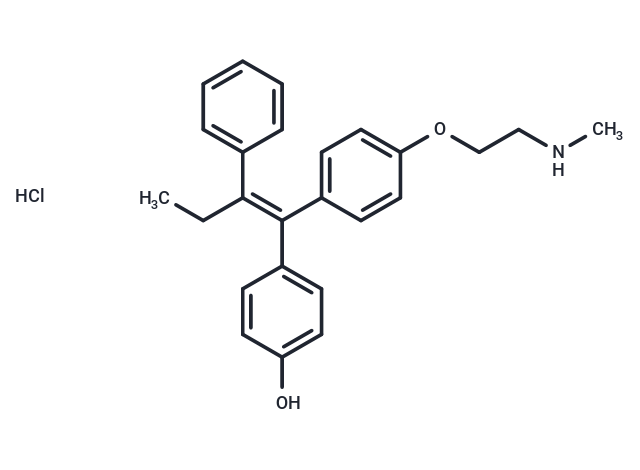Shopping Cart
Remove All Your shopping cart is currently empty
Your shopping cart is currently empty
Endoxifen hydrochloride, a principal active metabolite of Tamoxifen (TAM), exhibits heightened affinity and specificity towards the estrogen receptor and possesses aromatase inhibitory capability. It holds promise for breast cancer research.

| Pack Size | Price | USA Warehouse | Global Warehouse | Quantity |
|---|---|---|---|---|
| 5 mg | $41 | In Stock | In Stock | |
| 10 mg | $66 | In Stock | In Stock | |
| 25 mg | $133 | - | In Stock | |
| 50 mg | $232 | - | In Stock | |
| 100 mg | $374 | - | In Stock | |
| 1 mL x 10 mM (in DMSO) | $45 | In Stock | In Stock |
| Description | Endoxifen hydrochloride, a principal active metabolite of Tamoxifen (TAM), exhibits heightened affinity and specificity towards the estrogen receptor and possesses aromatase inhibitory capability. It holds promise for breast cancer research. |
| In vitro | Endoxifen, an hydroxylated metabolite of Tamoxifen, exhibits approximately 100-fold greater potency as an estrogen receptor (ER) antagonist compared to tamoxifen. Furthermore, it indicates that endoxifen, unlike 4-hydroxytamoxifen, induces degradation of ER-alpha in breast cancer cells in addition to its transcriptional effects on the ER.[1] Endoxifen acts as a potent antiestrogen that promotes the degradation of estrogen receptor α in breast cancer cells. Additionally, it has been demonstrated that endoxifen hinders ERA transcriptional activity and effectively suppresses estrogen-induced proliferation of breast cancer cells, even in the presence of tamoxifen, N-desmethyl-tamoxifen, and 4-hydroxytamoxifen.[2] Endoxifen exhibits significant growth inhibition at a concentration of 10 μM for all breast cancer cell lines, except for MDAMB-468, which shows moderate inhibition. At a concentration of 10 μM, cytotoxic effects are particularly prominent in MCF7, HS 578T, and BT-549 cells. In contrast, lower concentrations of Endoxifen (0.01-1 μM) result in less significant inhibitory effects compared to 10 μM. However, a concentration of 100 μM of Endoxifen is found to be lethal for all tested cells.[2] |
| In vivo | Endoxifen, when administered orally, is quickly absorbed and readily enters systemic circulation. Administering oral Endoxifen once daily for 28 consecutive days, at dosages of 2, 4, and 8 mg/kg, has demonstrated safety and progressive inhibition of human mammary tumor xenograft growth in female mice.[2] |
| Molecular Weight | 409.95 |
| Formula | C25H28ClNO2 |
| Cas No. | 1197194-41-4 |
| Smiles | Cl.CC\C(=C(/c1ccc(O)cc1)c1ccc(OCCNC)cc1)c1ccccc1 |
| Storage | Powder: -20°C for 3 years | In solvent: -80°C for 1 year | Shipping with blue ice/Shipping at ambient temperature. | ||||||||||||||||||||||||||||||||||||||||
| Solubility Information | H2O: 0.9 mg/mL (2.2 mM), Sonication and heating to 80℃ are recommended. DMSO: 55 mg/mL (134.16 mM), Sonication is recommended. | ||||||||||||||||||||||||||||||||||||||||
| In Vivo Formulation | 10% DMSO+40% PEG300+5% Tween 80+45% Saline: 2 mg/mL (4.88 mM), Sonication is recommended. Please add the solvents sequentially, clarifying the solution as much as possible before adding the next one. Dissolve by heating and/or sonication if necessary. Working solution is recommended to be prepared and used immediately. The formulation provided above is for reference purposes only. In vivo formulations may vary and should be modified based on specific experimental conditions. | ||||||||||||||||||||||||||||||||||||||||
Solution Preparation Table | |||||||||||||||||||||||||||||||||||||||||
H2O/DMSO
DMSO
| |||||||||||||||||||||||||||||||||||||||||
| Size | Quantity | Unit Price | Amount | Operation |
|---|

Copyright © 2015-2026 TargetMol Chemicals Inc. All Rights Reserved.